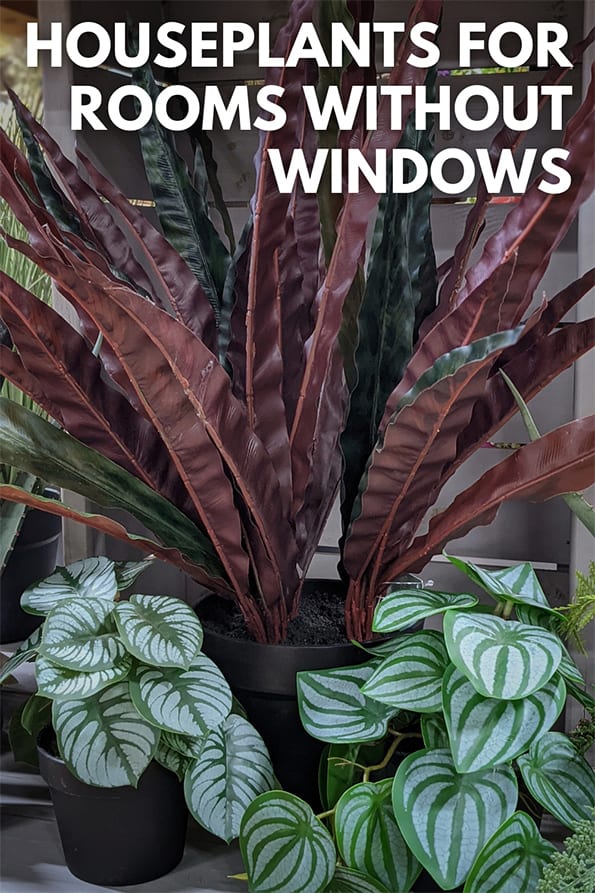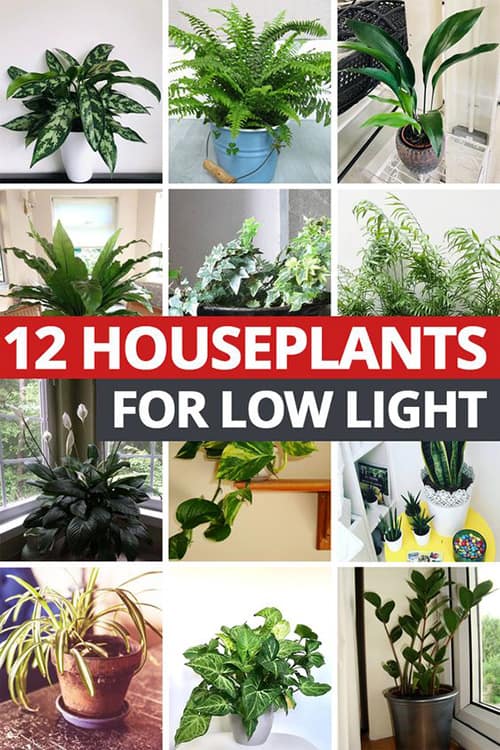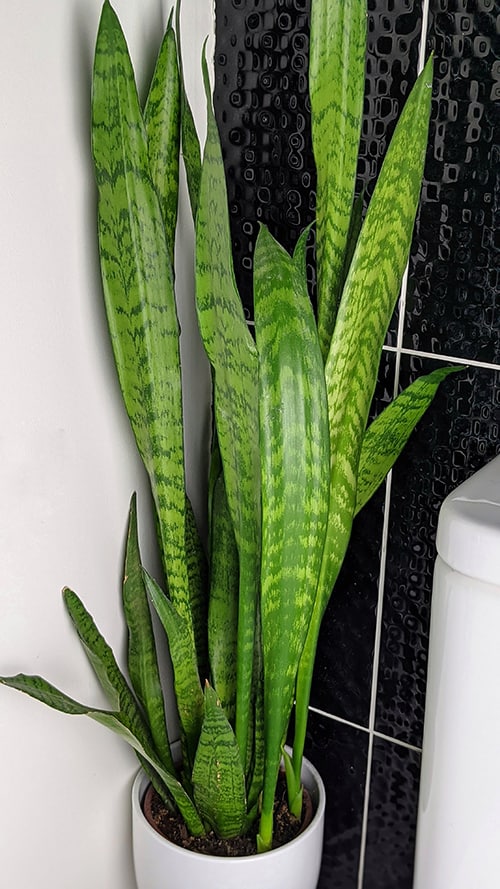Maybe you've got a basement snug, bathroom, or office space, all with no windows, but it's somewhere you still want to grow houseplants. Is this possible?
The good news is that you can put any houseplant in these dark places. The bad news is that most won't thrive or even grow.
And here is the even worse news. Some will survive a few months or so and still look brilliant (and I'll tell you which ones later on), but ultimately not a single houseplant will be suitable for a room with no light in the long term.
(Although, the ones in the photo below are true no light plants and can cope with the dark for years!).
At first glance, you may not notice, but these are actually fake plastic plants. Otherwise known as "The only houseplants that you can keep looking good in darkness forever".
Yes, only artificial plants will cope with permanent darkness with no complaints.
The fake ones these days can be pretty impressive and credit to the designers' craft with the realism. But if you're anything like me, you'll probably agree these plastic monstrosities have no place in our homes.
There are some workarounds and fixes you can put in place and in some circumstances you can successfully grow real houseplants in rooms without windows and by the end of this article, you'll know how.

Hi, I'm Tom!
If you're like me and enjoy the challenge of growing houseplants and getting them to thrive, then Ourhouseplants can help. This website shares my knowledge and years of growing plants and provides (hopefully) helpful advice on properly caring for your indoor plant friends.
I get a fair few people asking me on social media or by email why their plant in a windowless bathroom suddenly looks terrible, even though it's been in there for months without any issues.
On questioning why they're doing it, many will say they saw a blog post, a hack, or Tiktok telling them plants like the Snake Plant or Dumb Cane don't need bright light and can actually be grown in almost total darkness.
There is a lot of misinformation about houseplants on these platforms and it's rubbish.
Can I put a plant in a room with no windows?
The Chinese Evergreen, Spider Plant, Peace Lily, Cast Iron Plant, Parlor Palm, Lucky Bamboo and Pothos plants are often said to be able to thrive in rooms without windows. They can. But only with help.
Despite what people on Social Media might tell you, the simple truth is that no house plant can survive in permanent darkness.
For someone who has a life revolving around plants, I already know why that plant growing in your dark bathroom with less than an hour a day of weak fluorescent lighting looks like utter garbage. But people new to indoor plants might not know and that's okay and it's not something to be embarrassed about.
So let me make it make sense with a quick explanation.
Humans eat food that our bodies break down to provide energy. Plants on the other hand, make their own energy through photosynthesis and this is a light-dependent reaction.
All that means is that light is a vital part of the process; without it, photosynthesis can't occur, and the plant can't generate further energy.
They might then reply to me and say something like "but Tom, the plant was fine for weeks and weeks beforehand. I absolutely must have done something wrong, and it can't possibly be a lighting problem!".
So then I have to tell them why it's taken a while for the plants deprived of light to show problems.
If a human stops eating food, it takes days or longer before things get serious. The same with houseplants, removing light from a plant and preventing photosynthesis will not show immediate problems. In fact, many plants will still look perfectly good for weeks or even months after being moved into the dark.
Without getting too sciencey, all you really need to know is that some plants can store large amounts of energy, which they can "live off" for quite a while if needed.
You might be interested in watching an experiment on YouTube that shows all of this in practice. You'll also find out which two common houseplants can survive and still look almost perfect after being in the dark for full 100 days.
Here's AsapSCIENCE showing an experiment about how a number of low-maintenance plants do when grown in total darkness. (Click the image to watch).
Most of what I've said so far focuses on dark rooms or places like a windowless office, but what about if you have small amounts of natural light entering the room?
These locations would be classed as "low light". Although this still isn't good for most houseplants, some capable low-light plants will cope with this.
What you call "low light" can be very varied and it would be hard for me to give you exact definitions. For example a room with north-facing windows or a plant 10 foot away from a south-facing window could still create what's considered low light conditions. But depending on the amount of light, some plants will survive in these places for years.
I have an entire article that reveals the top plants that will cope with low light levels, so if you have a genuinely low light spot to fill take a look at this article instead and pick from these.
If the spot you want to fill with some life receives at least a little light, all these plants would be a great choice.
If you have a spot that's even darker, you won't be looking for the best plant for low light and you instead need to look at workarounds to boost the levels of light (all coming up in the next section below).
Alright, so let's say you really want live houseplants in dark windowless rooms that essentially receive zero natural daylight. What can you do to make that happen?
Here are some ideas you could think about putting into place.
The mother-in-law's tongue or Snake Plant (Sansevieria / Dracaena trifasciata) can survive and look good without any natural sunlight for many months.
Like all plants, houseplants need light to generate energy, and you can't get around that fact. So trying to grow houseplants in no light locations is typically not going to work in the medium to long term without help and adjustments to the room.
Some plants will cope with darkness for several months and so aesthetically you can have a living plant in these spaces. But they won't grow, or rather they won't grow "properly".
There are things you can do to bring light into a windowless room.
Distorted growth points or leggy stems are all common as the plant desperately tries to find natural sources of light nearby.
Windowless rooms usually have such poor light levels that plants won't be active at all, so only need a little water every now and again. Because they'll use such a small amount of water, it's very easy for them to be accidentally overwatered, take too long for the soil, or growing medium, to dry out and then root rot can set in pretty fast.
Yellow leaves, unattractive growth, and rotting all mean most houseplants won't make it in windowless rooms, and seeing all this happening will just stress you out, wondering what's wrong and what you can do to bring your plant back to health.
Top Tips
If you can provide enough light, basement rooms and bathrooms can be great places to grow resilient plants.
These areas often have high humidity too, so in some cases you can even try the odd tropical plant like the Prayer Plant or Maidenhair Fern. They're capable of dealing with low light situations, but there must still be some light.
I don't recommend growing plants like this in the first place is my advice. Instead find out how different light aspects affects your home and where plants want to be positioned, and you'll get better results and healthy-looking houseplants.
That being said, you can still do easy things to bring light into a room. This can include specially designed grow lights which will let you grow most plants that demand "bright indirect light" or even "bright sunlight" to do well.
This could include tropical plants, like the Boston Fern or Anthuriums. Flowering plants like Moth Orchids or Calla Lilies and in some cases, cacti or succulents like the Aloe Vera.
Even regular light bulbs or leaving the door open to the windowless room, can all change the space into a suitable growing habitat for adaptable low light houseplants like English Ivy or the Bird's Nest Fern. They won't thrive in these places, but they'll probably get by, allowing you to enjoy their presence for quite a while.


